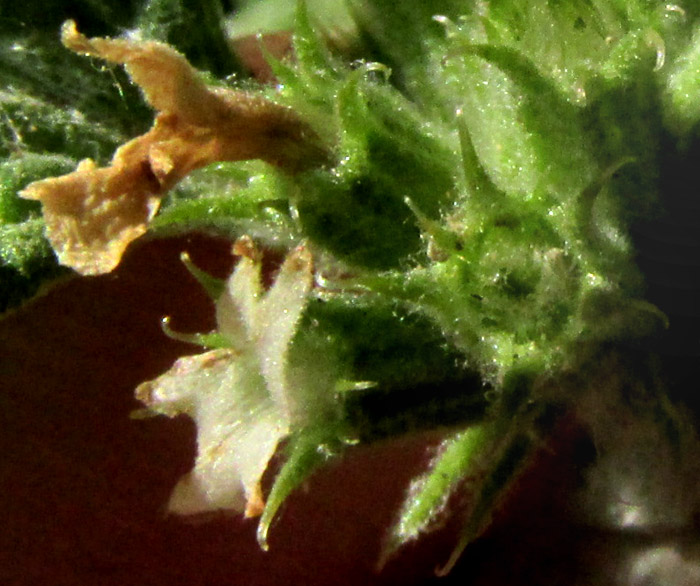Excerpts from Jim Conrad's
Naturalist Newsletter
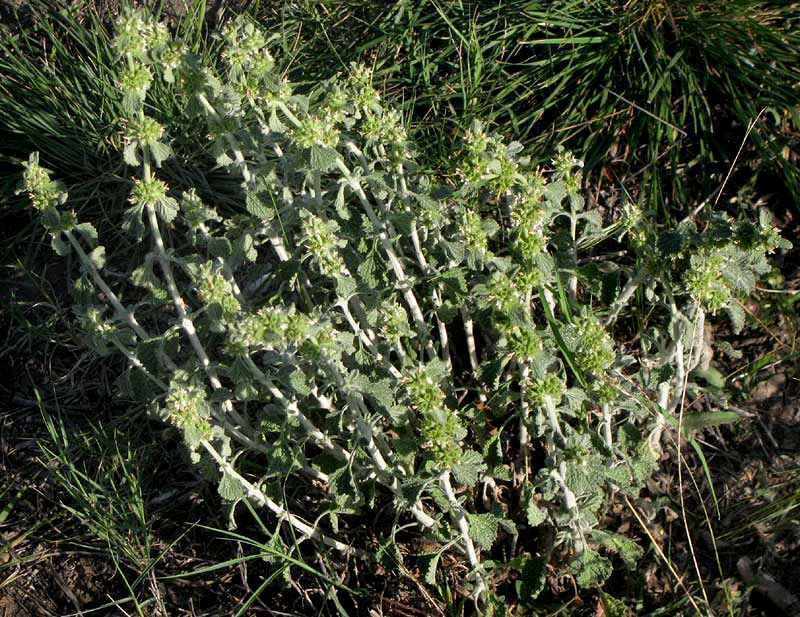
from the the May 5, 2013 Newsletter issued from the Frio Canyon Nature Education Center in northern Uvalde County, southwestern Texas, on the southern border of the Edwards Plateau; elevation ~1750m (~5750 ft); N29.62°, W99.86°; USA
HOREHOUND
Growing wild in the garden and the grassy area around the cabin as well as along roadsides and in disturbed places in general nowadays there's a foot-tall, bushy, perennial herb with white wooly hair thickly covering its stems and leaves, as shown above. Below, a close-up helps you better see the herb's white, somewhat four-cornered stems and deeply wrinkled, opposite leaves (two leaves to a stem node):
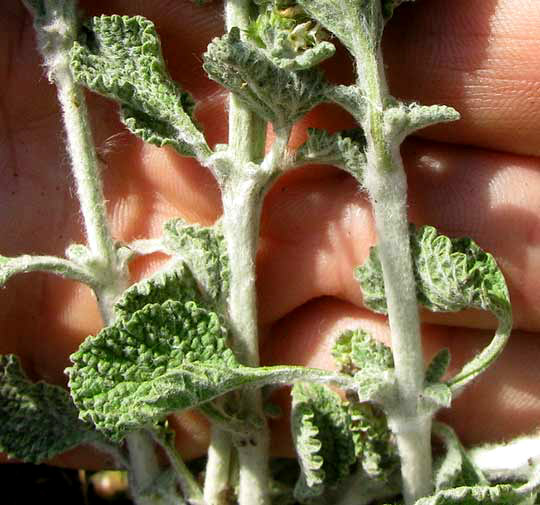
The plant's 3/8ths-inch (8mm) long flowers are arranged in spherical clusters well separated from one another at stem tops, each cluster subtended by two small leaves, as shown below:
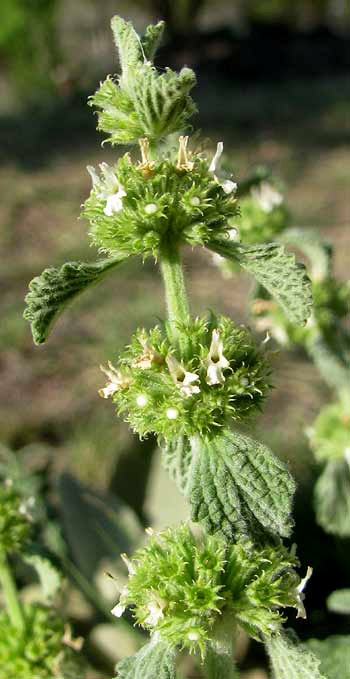
You can see that the flowers themselves are like white little dog faces, bilaterally symmetrical, with distinct upper lips and lower ones, the upper with a deep notch at the tip, the lower with three broad lobes.
Seeing the herb's squarish stems, opposite leaves and bilaterally symmetrical flowers arranged in such clusters, you automatically think of the Mint Family, the Lamiaceae, and this certainly is a kind of mint, despite it not smelling so minty when you crush a leaf between your fingers. But, one authority states that the Mint Family embraces 236 genera and more than 7000 species -- the family's boundaries are still unclear -- so which Mint Family Member do we have here?
With all that white hair covering the plant, including inside the calyx, and with the flowers arranged as they are in clusters separated on the stem (said to be "verticillate"), and the extra information that each flower has four stamens and not two, this interesting little plant reveals itself as an herb that once was much more famous than it is now, though it's still pretty well known in some parts of the world. This is the Horehound, MARRUBIUM VULGARE, an Old World species much planted worldwide, and often escaped into the wild, as is the case here.
When I was a kid back in the 50s my mother sometimes bought me Horehound candy, which I remember as being like sweet gravel with a certain oily-menthol taste. Even back then it was regarded as an old-time sweet, and no kid would prefer it to anything else on the candy shelf. I liked it not only because I was a fat kid that liked nearly everything to eat, but because the name horehound sounded a little risqué. Actually, the name is an old one, long applied to this very plant, which for centuries has been an important presence in family gardens. The name horehound derives from the Old English harhune, the "har" meaning hoar or hoary, like white frost. So, it's sort of a funny name, "white hound," nothing risqué about it.
Horehound has been in people's gardens for so long not only because you can make horehound candy from it but because it's considered medicinal, used mainly for suppressing coughs and clearing the lungs. Boil the whole plant to make a tea for the common cold. Also it's touted as being good for a long list of other ailments, from diabetes to gallbladder problems, from loss of appetite to flatulence. Externally it's prescribed for cleaning wounds, and for a variety of other temporary and persistent skin disorders.
I gathered a handful of leaves and stems, made a tea of them and the tea was bitter exactly as you'd want a medicinal tea to be. Later I'll pull a couple of armloads and hang them to dry in preparation for this winter when sniffles and colds are going around. Already I have rafters hung with the Rabbit Tobacco we looked at last November. I figure that a tea made with both Rabbit Tobacco and Horehound might be worth trying if you're coughing and sneezing.
I'm not picking the Horehound now because those little white flowers are powerfully attractive to bees and butterflies.
Horehound is a wonderful plant, but it must be admitted that in some places it's become a serious weed, especially in Australia. It can take over rangeland because livestock don't like to eat its bitter herbage. Horehound survives in pastures and rangeland where other species are eaten to extinction.
entry dated May 25, 2023, issued from near Tequisquiapan; elevation about 1,900m, (6200 ft), ~N20.57°, ~W99.89°; Querétaro state, MÉXICO
(~N20.55°, ~W99.89°)
HOREHOUND FLOWERS
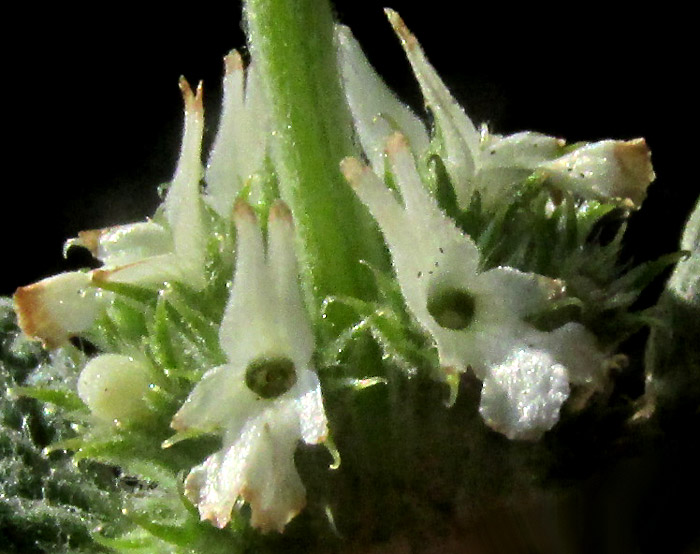
In upland central Mexico, after meeting the plant in Texas {see above} this time I get close-ups of Horehound flowers, seen above, when a single plant turns up in a usually-shaded gully below a country person's house where garbage sometimes is tossed. The corolla is typical of the Mint Family, but the split in the top lobe is a little unusual. Horehound is bee pollinated, so I'll be watching to see if bees somehow benefit from the divided top lobe during their visits. After pollination, the corollas turn brown and fall off, leaving developing nutlets inside the calyx. The calyx itself is provided with five stiff, pointy, upward-projecting sepals which might dissuade caterpillars from feeding on the fruits:
